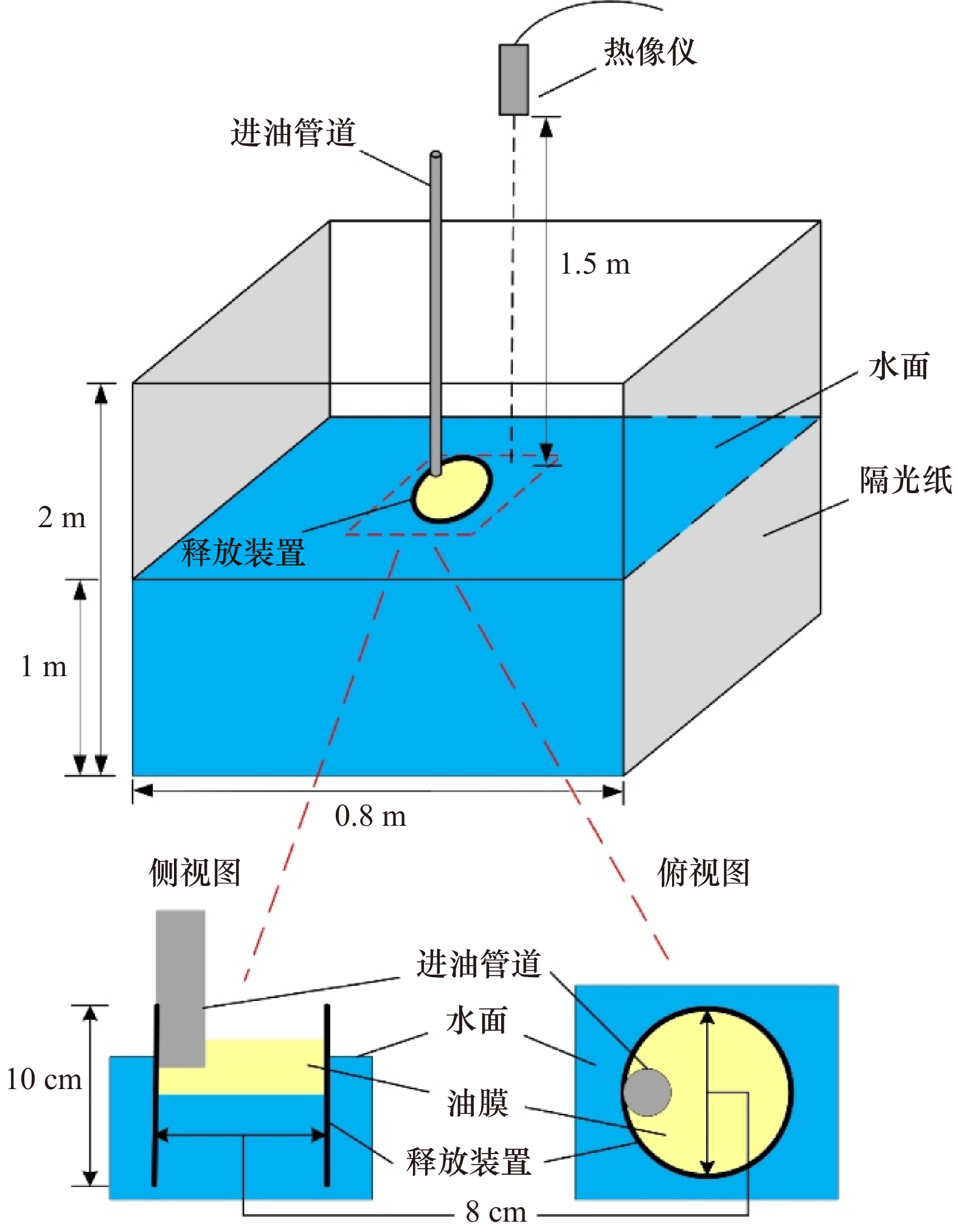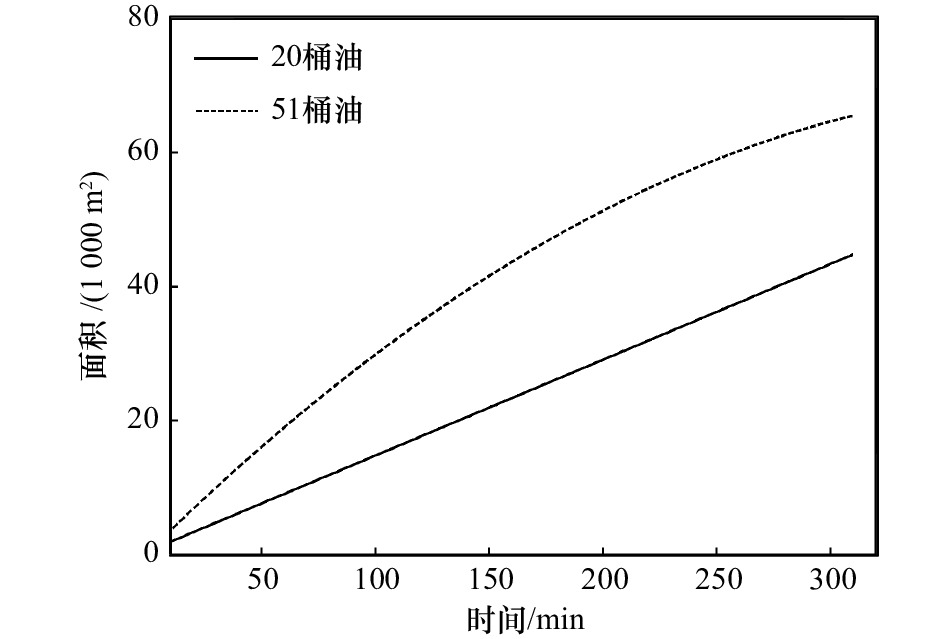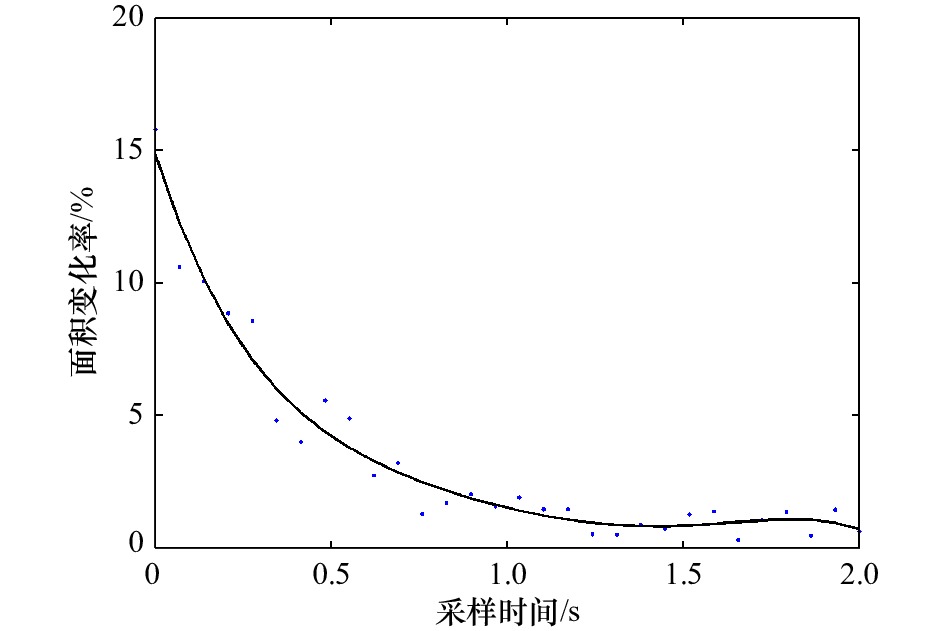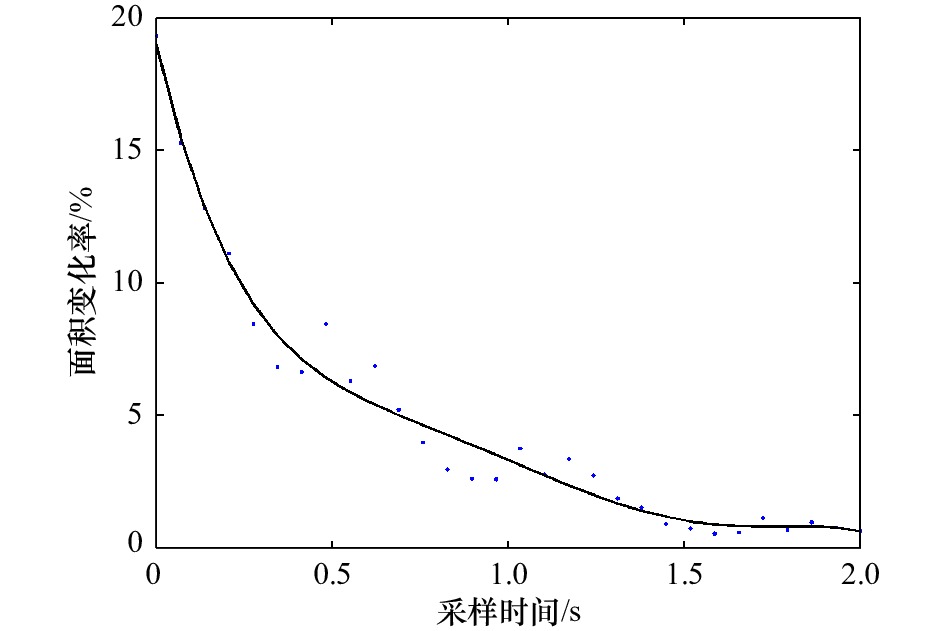Research on identification of marine oil spill based on thermal infrared video image monitoring
-
摘要: 针对现有海面溢油检测技术难以在石油泄漏初期(尚未形成海面大规模油膜覆盖)及时发现油膜的难题,本文在前期基于热红外图像测算海面油膜面积方法研究的基础上,结合油泄漏至海面后油膜的扩散特征,提出了一种基于热红外视频图像监测油膜面积变化以及时识别海面溢油的方法。首先,基于单帧热红外图像处理算法提取海面前景区域(包含油膜区域与相似物干扰区域)并计算各区域所代表的实际物理面积。基于视频图像处理技术跟踪测算前景区域中各连通区域的实际物理面积变化情况,根据各连通区域的面积变化率识别前景区域中是否存在油膜,从而判断海面是否发生溢油。实验结果表明:所提出的方法能有效识别不同黏度的石油泄漏至海面形成的扩散油膜,在水面包含波浪与相似物干扰时也具有良好的识别精度。该方法适用于特定场景下(如码头、船舶等)的溢油事故的鉴别,能为溢油事故的及时发现和预警提供技术支持。Abstract: When oil spill occurs and the large scale covering on the sea surface has not been formed, it is hard to find oil film by existing oil spill detection technology. To solve this problem, a novel method for discriminating of oil spill by monitoring the area of oil film is presented based on thermal infrared video image, which combined with the diffusion characteristic of oil spill. Firstly, foreground regions (real oil film region and look-alikes interference region) on the sea surface are extracted and the actual physical area of each region is calculated based on single-frame thermal infrared image processing (i.e., the pixel area calculation method from the previous research). According to the video image processing, the change of the actual physical area of each region is tracked in real-time. The area change rate threshold is set to discriminate whether oil film on the foreground regions, then whether oil spill happened can be determined. The experimental results show that the proposed method can effectively discriminate oil film formed by different viscosity of oil and maintain good identification accuracy under sea surface with waves and floating objects. This strategy is suitable for specific scenes such as wharves and ships, and also can provide technical support for pollution control of oil spill.
-
图 3 水槽实验平静水面条件下的20W-50成品油单帧图像处理结果
a. 原始热红外图像;b. 预处理结果;c. 前景区域分割结果;d. 面积计算结果
Fig. 3 Image processing results of 20W-50 refined oil under calm water surface in tank experiment
a. Original thermal infrared image; b. preprocessing result; c. segmentation result of foreground region; d. area calculation result
图 4 含漂浮物干扰的水槽实验条件下的0W-20成品油单帧图像处理结果
a. 原始热红外图像;b. 预处理结果;c. 前景区域分割结果;d. 面积计算结果
Fig. 4 Image processing results of 0W-20 refined oil under water surface with floating objects in tank experiment
a. Original thermal infrared image; b. preprocessing result; c. segmentation result of foreground region; d. area calculation result
图 5 水槽实验平静水面条件下的20W-50成品油多帧图像处理结果
a. 原始热红外图像;b. 阈值分割结果;c. 面积计算结果;d. 感兴趣的油膜区域标记结果
Fig. 5 Multi-frame image processing results of 20W-50 refined oil under calm water surface in tank experiment
a. Original thermal infrared images; b. threshold segmentation results; c. area calculation results; d. region of interest marked results
图 6 水槽实验含波浪干扰水面条件下20W-50成品油多帧图像处理结果
a. 原始热红外图像;b. 阈值分割结果;c. 面积计算结果;d. 感兴趣的油膜区域标记结果
Fig. 6 Multi-frame image processing results of 20W-50 refined oil under water surface with waves in tank experiment
a. Original thermal infrared images; b. threshold segmentation results; c. area calculation results; d. region of interest marked results
图 7 水槽实验含波浪干扰水面条件下的0W-20成品油多帧图像处理结果
a. 原始热红外图像;b. 阈值分割结果;c. 面积计算结果;d. 感兴趣的油膜区域标记结果
Fig. 7 Multi-frame image processing results of 0W-20 refined oil under water surface with waves in tank experiment
a. Original thermal infrared images; b. threshold segmentation results; c. area calculation results; d. region of interest marked results
图 8 含漂浮物干扰的水槽实验条件下的20W-50成品油多帧图像处理结果
a. 原始热红外图像;b. 阈值分割结果;c. 面积计算结果;d. 感兴趣的油膜区域标记结果
Fig. 8 Multi-frame image processing results of 20W-50 refined oil under water surface with floating objects in tank experiment
a. Original thermal infrared images; b. threshold segmentation results; c. area calculation results; d. region of interest marked results
图 9 含漂浮物干扰的水槽实验条件下的0W-20成品油多帧图像处理结果
a. 原始热红外图像;b. 阈值分割结果;c. 面积计算结果;d. 感兴趣的油膜区域标记结果
Fig. 9 Multi-frame image processing results of 0W-20 refined oil under water surface with floating objects in tank experiment
a. Original thermal infrared images; b. threshold segmentation results; c. area calculation results; d. region of interest marked results
图 14 水槽实验含波浪干扰水面条件下20W-50成品油图像感兴趣的油膜区域提取结果对比
a. 第6帧热红外图像;b. GMM;c. WEBS;d. SFS;e. 本文方法
Fig. 14 Comparison of region of interest extraction results of 20W-50 refined oil image under water surface with waves in tank experimsent
a. The 6th frame thermal infrared image; b. GMM; c. WEBS; d. SFS; e. proposed method
图 15 含漂浮物干扰的水槽实验条件下的20W-50成品油图像感兴趣的油膜区域提取结果对比
a. 第16帧热红外图像;b. GMM;c. WEBS;d. SFS;e. 本文方法
Fig. 15 Comparison of region of interest extraction results of 20W-50 refined oil image under water surface with floating objects in tank experiment
a. The 16th frame thermal infrared image; b. GMM; c. WEBS; d. SFS; e. proposed method
表 1 Fotric288参数规格
Tab. 1 Specifications of the Fotric288
参数 规格 工作波段 8~14 μm NETD $\leqslant $30 mK 视场角 25°×19° 镜头焦距 12 mm 分辨率 640×480 帧率 30帧/s 表 2 实验条件
Tab. 2 Experimental condition setting
编号 石油样品 水面环境 干扰类型 ① 20W-50成品油 平静水面 无 ② 20W-50成品油 含波浪干扰 30 cm振幅的规则波 ③ 20W-50成品油 含漂浮物干扰 10 cm×10 cm泡沫板 ④ 0W-20成品油 含波浪干扰 30 cm振幅的规则波 ⑤ 0W-20成品油 含漂浮物干扰 10 cm×10 cm泡沫板 表 3 不同方法的感兴趣的油膜区域提取效果对比
Tab. 3 Comparison of region of interest extraction results of different methods
实验条件 处理方法 F-Measure 每帧处理时间/s 平静海面 GMM 0.064 0.458 WEBS 0.933 0.328 SFS 0.952 0.943 本文 0.973 0.194 波浪干扰 GMM 0.068 0.461 WEBS 0.936 0.366 SFS 0.957 0.924 本文 0.969 0.195 漂浮物干扰 GMM 0.067 0.477 WEBS 0.897 0.343 SFS 0.863 0.947 本文 0.911 0.208 -
[1] Lehr W J, Cekirge H M, Fraga R J, et al. Empirical studies of the spreading of oil spills[J]. Oil and Petrochemical Pollution, 1984, 2(1): 7−11. doi: 10.1016/S0143-7127(84)90637-9 [2] Leifer I, Lehr W J, Simecek-Beatty D, et al. State of the art satellite and airborne marine oil spill remote sensing: application to the BP Deepwater Horizon oil spill[J]. Remote Sensing of Environment, 2012, 124: 185−209. doi: 10.1016/j.rse.2012.03.024 [3] Svejkovsky J, Hess M, Muskat J, et al. Characterization of surface oil thickness distribution patterns observed during the Deepwater Horizon (MC-252) oil spill with aerial and satellite remote sensing[J]. Marine Pollution Bulletin, 2016, 110(1): 162−176. doi: 10.1016/j.marpolbul.2016.06.066 [4] 李四海. 海上溢油遥感探测技术及其应用进展[J]. 遥感信息, 2004(2): 53−57. doi: 10.3969/j.issn.1000-3177.2004.02.015Li Sihai. Application of remote sensing for oil slicks detecting and its progress[J]. Remote Sensing Information, 2004(2): 53−57. doi: 10.3969/j.issn.1000-3177.2004.02.015 [5] Fingas M, Brown C E. A review of oil spill remote sensing[J]. Sensors, 2017, 18(2): 91. [6] 景海朋. 基于红外图像的水面溢油检测及系统实现[D]. 西安: 西安电子科技大学, 2014.Jing Haipeng. Surface oil spill detection and system implementation based on infrared image[D]. Xi’an: Xidian University, 2014. [7] 蒋兴伟, 何贤强, 林明森, 等. 中国海洋卫星遥感应用进展[J]. 海洋学报, 2019, 41(10): 113−124.Jiang Xingwei, He Xianqiang, Lin Mingsen, et al. Progresses on ocean satellite remote sensing application in China[J]. Haiyang Xuebao, 2019, 41(10): 113−124. [8] 任广波, 过杰, 马毅, 等. 海面溢油无人机高光谱遥感检测与厚度估算方法[J]. 海洋学报, 2019, 41(5): 146−158.Ren Guangbo, Guo Jie, Ma Yi, et al. Oil spill detection and slick thickness measurement via UAV hyperspectral imaging[J]. Haiyang Xuebao, 2019, 41(5): 146−158. [9] Lacava T, Ciancia E, Coviello I, et al. A MODIS-based robust satellite technique (RST) for timely detection of oil spilled areas[J]. Remote Sensing, 2017, 9(2): 128. doi: 10.3390/rs9020128 [10] Shu Yuanming, Li J, Yousif H, et al. Dark-spot detection from SAR intensity imagery with spatial density thresholding for oil-spill monitoring[J]. Remote Sensing of Environment, 2010, 114(9): 2026−2035. doi: 10.1016/j.rse.2010.04.009 [11] 陈韩, 谢涛, 方贺, 等. 基于SAR极化比和纹理特征的海面溢油识别方法[J]. 海洋学报, 2019, 41(9): 181−190.Chen Han, Xie Tao, Fang He, et al. Sea surface oil spill identification method based on SAR polarization ratio and texture feature[J]. Haiyang Xuebao, 2019, 41(9): 181−190. [12] 尹奇志, 初秀民, 孙星, 等. 船舶溢油监测方法的应用现状及发展趋势[J]. 船海工程, 2010, 39(5): 246−250.Yin Qizhi, Chu Xiumin, Sun Xing, et al. Application and development trend of detecting techniques for oil slick from vessel[J] Ship & Ocean Engineering, 2010, 39(5): 246−250. [13] 张果. 近距离海面溢油监测系统的设计与实现[D]. 西安: 西安电子科技大学, 2018.Zhang Guo. Design and implementation of close-range sea surface spill oil monitoring system[D]. Xi’an: Xidian University, 2018. [14] Bagavathiappan S, Lahiri B B, Saravanan T, et al. Infrared thermography for condition monitoring—A review[J]. Infrared Physics & Technology, 2013, 60: 35−55. [15] De Carolis G, Adamo M, Pasquariello G. On the estimation of thickness of marine oil slicks from sun-glittered, near-infrared MERIS and MODIS imagery: the Lebanon oil spill case study[J]. IEEE Transactions on Geoscience and Remote Sensing, 2014, 52(1): 559−573. doi: 10.1109/TGRS.2013.2242476 [16] Niclòs R, Doña C, Valor E, et al. Thermal-infrared spectral and angular characterization of crude oil and seawater emissivities for oil slick identification[J]. IEEE Transactions on Geoscience and Remote Sensing, 2014, 52(9): 5387−5395. doi: 10.1109/TGRS.2013.2288517 [17] Lu Yingcheng, Zhan Wenfeng, Hu Chuanmin. Detecting and quantifying oil slick thickness by thermal remote sensing: a ground-based experiment[J]. Remote Sensing of Environment, 2016, 181: 207−217. doi: 10.1016/j.rse.2016.04.007 [18] Zhou Yang, Jiang Lu, Lu Yingcheng, et al. Thermal infrared contrast between different types of oil slicks on top of water bodies[J]. IEEE Geoscience and Remote Sensing Letters, 2017, 14(7): 1042−1045. doi: 10.1109/LGRS.2017.2694609 [19] Akula A, Ghosh R, Kumar S, et al. Moving target detection in thermal infrared imagery using spatiotemporal information[J]. Journal of the Optical Society of America A, 2013, 30(8): 1492−1501. doi: 10.1364/JOSAA.30.001492 [20] 李艳荻, 徐熙平. 基于超像素时空特征的视频显著性检测方法[J]. 光学学报, 2019, 39(1): 315−322.Li Yandi, Xu Xiping. Video saliency detection method based on spatiotemporal features of superpixels[J]. Acta Optica Sinica, 2019, 39(1): 315−322. [21] 王利锋, 辛丽平, 于波, 等. 基于热红外图像的海面油膜面积的测算方法[J]. 海洋通报, 2020, 39(6): 750−760.Wang Lifeng, Xin Liping, Yu Bo, et al. A calculation method for oil film area at sea surface based on thermal infrared image[J]. Marine Science Bulletin, 2020, 39(6): 750−760. [22] Otsu N. A threshold selection method from gray-level histograms[J]. IEEE Transactions on Systems, Man, and Cybernetics, 1979, 9(1): 62−66. doi: 10.1109/TSMC.1979.4310076 [23] 刘伯运, 赵博, 王腾. 基于连续帧图像面积变化的火灾探测方法[J]. 消防科学与技术, 2016, 35(12): 1723−1725. doi: 10.3969/j.issn.1009-0029.2016.12.022Liu Boyun, Zhao Bo, Wang Teng. A fire detection method based on the area variety of consecutive frames[J]. Fire Science and Technology, 2016, 35(12): 1723−1725. doi: 10.3969/j.issn.1009-0029.2016.12.022 [24] 刘松涛, 刘振兴, 姜宁. 基于融合显著图和高效子窗口搜索的红外目标分割[J]. 自动化学报, 2018, 44(12): 2210−2221.Liu Songtao, Liu Zhenxing, Jiang Ning. Target segmentation of infrared image using fused saliency map and efficient subwindow search[J]. Acta Automatica Sinica, 2018, 44(12): 2210−2221. -





 下载:
下载:














